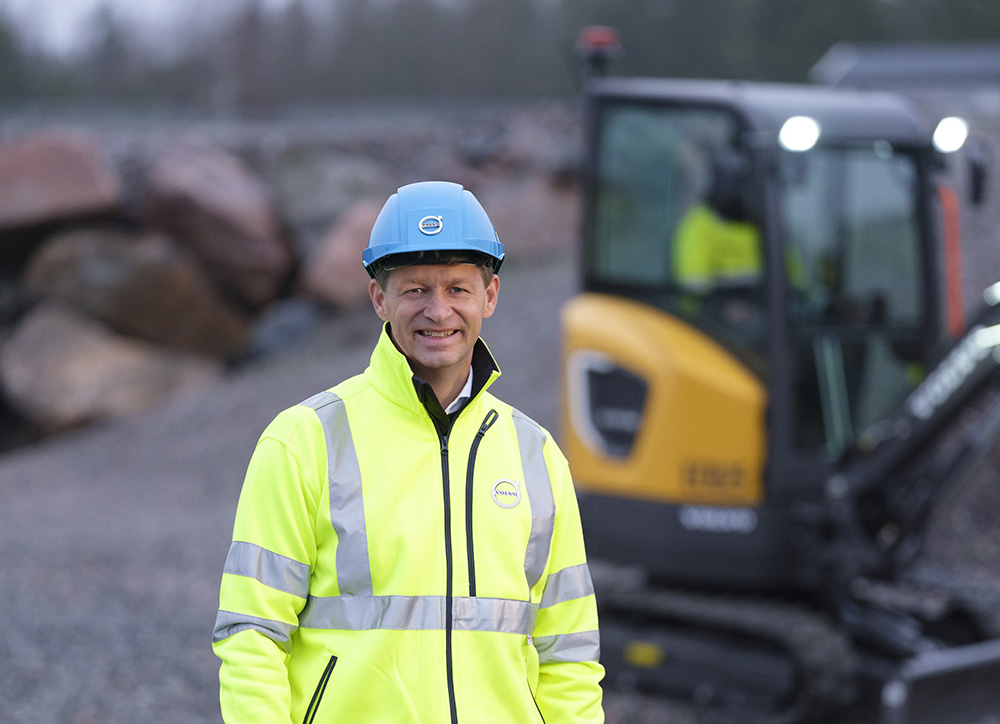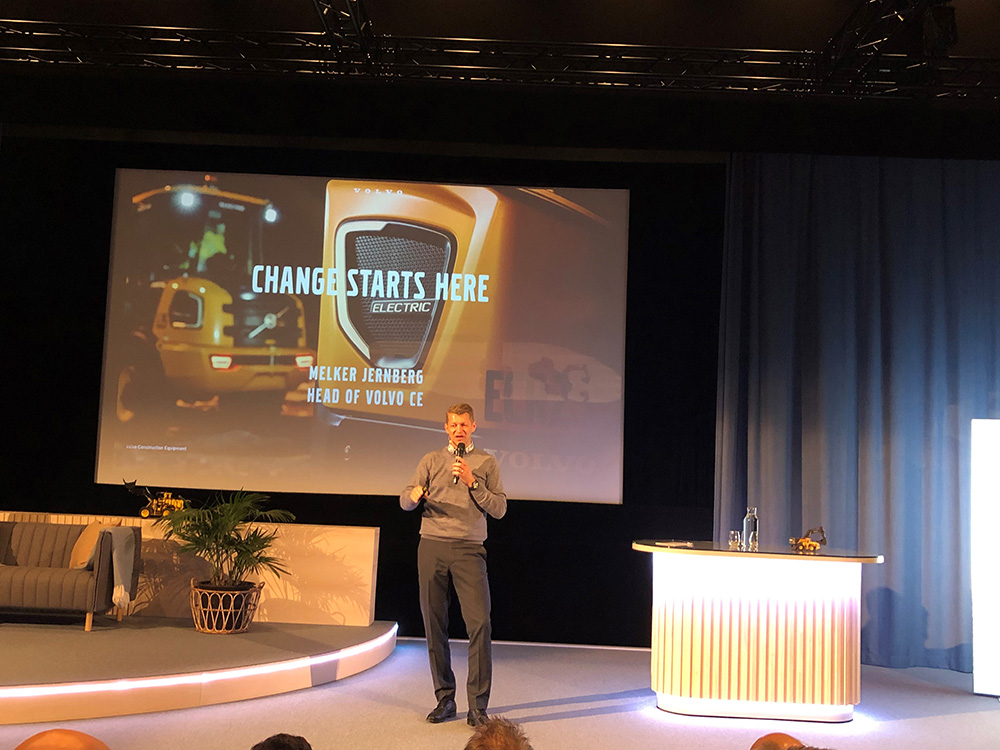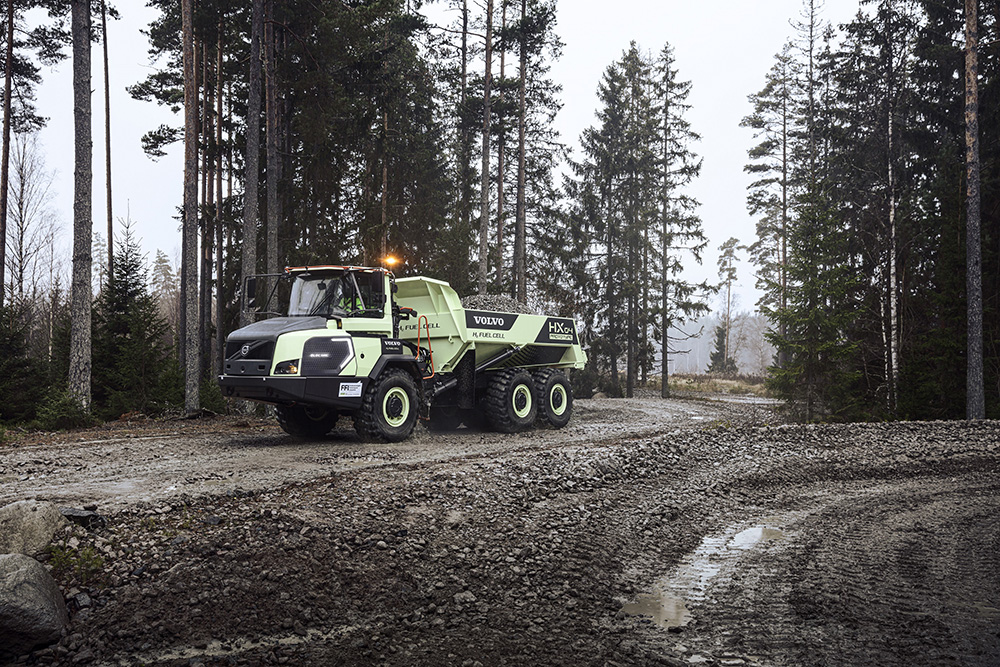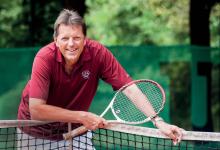
Volvo is a manufacturer that has put itself at the centre of efforts to advance quarrying and construction equipment technology in areas such as electric and autonomous vehicle deployments.
Melker Jernberg became president of the Volvo CE (Construction Equipment) business in January 2018, and his academic and professional background in mechanical engineering makes him well-equipped to spearhead the company’s efforts in these areas.
The manufacturer recently unveiled the world’s first pilot of a hydrogen fuel cell-powered articulated hauler, addressing the issue of how electric power could be used for large quarrying machinery. Volvo CE is also an early mover in autonomous electric quarrying vehicles with its joint project at the Skanska ‘electric quarry’ in Gothenburg and through its TARA autonomous vehicle solution.
A graduate of the KTH Royal Institute of Technology in Stockholm with an MSc in Mechanical Engineering, Jernberg started his career at commercial vehicle manufacturer Scania in 1989, where he worked for 22 years, ultimately becoming senior VP with responsibility for Scania’s bus and coach business area.
He then joined Swedish steel maker SSAB in 2011 where he ran the company’s European, Middle Eastern and African businesses.
Speaking to Aggregates Business Europe during the press day at the start of June’s Volvo Days showcase for Volvo CE’s latest equipment and technology, Jernberg expressed his happiness that it could be held face to face for the first time since 2018.
The three-week event is held at Volvo CE’s Customer Center in Eskilstuna, central Sweden, and Jernberg said the last few years have been a tough period for all, with the off-road equipment sector being no exception. “We normally talk to partners, suppliers, customers, dealers, [at Volvo Days] and we haven’t been doing that for a number of years. That is bad and sad, and also a bit strange.
“We were a little bit surprised about the extreme increase in demand that came quite quickly [after the lockdown], and at the same time there were very big challenges on the supply side. We have been living with that for a long time now, there has been a constant kind of crisis management for the last two-and-a-half years.”

In number terms Volvo CE sold 99,871 machines in 2021 (321 of which were electric-powered) in a global market that totalled just under one million units for the year. Sales of services represented 14% of the company’s total sales, and its operating income margin was 13.3%.
Jernberg says that the post-COVID situation has been exacerbated this year by the lengthy renewed lockdowns in Shanghai, where Volvo CE’s Chinese business is headquartered, and the Russian invasion of Ukraine.
“Normally, if you have one or two of these kinds of crises you can manage them, but now we have a long list,” he states, adding that suppliers themselves have been hit by COVID, both on the people and the materials side.
“When it started, a lot of the debate was around the shortage of semiconductors and inability to meet global demand, and of course that hit us as well. But it’s wider than just semiconductors, it’s also the hydraulics and electronics in machines, the raw materials. You can take almost anything. On top of that there are the logistic challenges. It’s not one crisis, one supplier or transport system, it’s all over the system, and that is something that we’ve never experienced before. Our suppliers have done fantastic things trying to solve this.”
In terms of whether the situation is getting better, he says: “So many times over the last two and a half years one has said ‘Yes, it’s improving’, and then you wake up with another hit. In some areas there are no improvements, but in some of our critical flows we are starting to see things becoming better.”
Despite the current challenges, Jernberg highlights a number of key drivers for Volvo CE’s business going forward: sustainability, new technologies, solutions/services, and partnerships.
Commenting on how sustainability and new technologies can drive Volvo CE’s business, he says that discussions with its customers have shown a need for electric machinery is coming from the bigger applications, including quarries.
In addition to its electric battery-powered machines, the company has also made major recent announcements about equipment in the hybrid and hydrogen fuel cell areas.
“It’s important to look at the whole spectrum of solutions,” he adds. “One option is fully electric, but quarries are often also very suited to grid-connected machines, which we already have available today.
“Another concept we have come up with for mining is a kind of transport system, which is electric but also fully autonomous [TARA]. It’s important to take a holistic view of the site. The main use [for electric and autonomous deployments] will be hauling, but then you can complement that with excavators and wheeled loaders to have a full system. You can recharge quite often during each cycle and don’t need to have heavy batteries.”
For electric excavators in quarries at the moment, Jernberg says he would recommend them being fully connected to the grid to enable the deployment of bigger machines including 50-tonne models. Currently the largest battery-powered excavator that Volvo CE produces is the 22-tonne EC230 Electric, but he says it will be possible to make bigger battery-electric machines than the ones currently on the market.
In terms of the adoption of alternative power technologies in sectors such as quarrying, he stresses the need for a flexible approach among manufacturers to be able to produce solutions for the whole range of vehicle-powering technologies - whether it be lithium battery, hydrogen, other alternative fuels, cable-connected power from the grid, or existing diesel engines.
“This will change and this is why I am pushing on the other fuel solutions such as hydrogen, which will be fully electric but through the fuel cells,” says Jernberg. “On the bigger machines we will have CO2-free solutions, but maybe not through battery electric only. I think that is how we should see it.
“We learn every day, and if we lock ourselves into a plan now until 2030 it will be dangerous to do that. We are working hard to be sensitive and to adjust on the timescale. Time to market, technology development – all of these things give a lot of opportunities short-term. You need to be quick out, but with good products.”
In June, Volvo CE announced that it has started testing the world’s first fuel cell articulated hauler prototype, the Volvo HX04. The fuelling process for hydrogen vehicles is fast and the Volvo HX04 can be charged with 12kg hydrogen in around 7.5 minutes, enabling it to operate for approximately four hours.
“We are testing hydrogen solutions for use in applications such as quarrying,” says Jernberg. “To be able to fully launch it we need some more testing and maturity, and fuel cells are still quite expensive. To be fully up and running from a commercial point of view I think it will take a few more years until it’s matured.”
He says that there is a lot of interest among Volvo CE customers for electric and autonomous solutions. Many of the company’s big customers and strategic accounts have made similar pledges to its own to fulfil the Paris Agreement requirements on reducing emissions, and to achieve this through the pathway provided by science-based targets.
Volvo CE says it is fully committed to the Science-Based Targets initiative, and reaching net-zero value-chain emissions by 2040.
“I’m surprised at the speed with which things are progressing for electric solutions even in big, more mature regions and countries, and this is important,” says Jernberg.
In terms of potential barriers to the rollout of electric solutions, he identifies the levels of power generation that are available for operating vehicles as an issue that needs to be solved, in addition to the capabilities of manufacturers to put good-enough products on the market.
He points out that, in addition to equipment operators’ own desire to improve their sustainability efforts, pressure is also increasingly coming from the bodies awarding supply contracts who require evidence of a low CO2 footprint.
Advances in vehicle-charging technology are another way of driving uptake. “If you take a big quarry with eight large machines, then if you can cut the current kilowatt-hour-cost of vehicle charging by 50% this would put it on the same cost level as diesel,” Jernberg says. “Are operators willing to pay let’s say an extra 2% to deploy a CO2 -free solution?”
He says that total cost of ownership is very important and this will influence the customer in terms of whether they switch to electric now, or if they wait for another year.
“Today we still believe in the future of the combustion engine, because that technology is proven. But there will be different types of fuels and even hydrogen and other alternative fuels [including biofuels such as HVO] in the combustion engine. We have a deadline of 2040 to be a net-zero company, and by then we know we will not have diesel in the combustion engine anymore.”
Volvo CE has a target for at least 30% of the machines it produces to be electric by 2030. “To be able to contribute to the Paris Agreement we have said that we have committed to make absolute reductions in CO2 emissions in the use of our products by 30%. When you actually calculate that it means that 35% rather than 30% of our machines will be fully electric.
“The efficiency of the whole system is also important. For every customer we discuss this with – whether it’s autonomous or not, electric or not – a holistic view of the site can enable large percentage savings in CO2 for the quarry of the future. The whole solution and what we can do in terms of connectivity is very important in this context now.”
Volvo has started a separate business within the group – Volvo Autonomous Solutions (VAS ) – that is specifically dedicated to the technology. Jernberg says that the first full deployments of Volvo CE’s autonomous transport solution – tagged TARA – should take place either late this year or early in 2023.
He adds that an autonomous system will not be a perfect solution for 100% of all quarry sites, but it can be suitable for many of them. “It’s more the maturity of us together with our customers, rather than depending on a specific market,” he says.
Moving onto the topic of Volvo Group-owned articulated hauler manufacturer Rokbak (which rebranded from Terex Trucks in September 2021), Jernberg says the intention is to keep the Rokbak operation as separate from its parent company as possible.
“We cooperate because we are in the same company, and Paul [Douglas, Rokbak MD] and the whole team are good colleagues to us. Of course, it’s a family party when we meet, but business-wise it’s separate. It’s a separate brand, produced at the plant in Motherwell, Scotland, with separate distribution and values coming from those machines compared with Volvo.”
Looking to how Volvo CE’s business performance will progress over the next 12 months, Jernberg says that the complicating factor in making projections is China, where the company is very strong and where a large part of its 2021 volumes came through its SDLG brand.
“China plays a major role in the construction industry when you look at global order intakes, volumes and sales, so that has altered the mathematics and changed the whole dynamic,” he says.
China, which represents around a half of the global construction equipment market, has seen sales fall by 50% this year.
“If you take a company that is not strong in China, the last three years will be completely different to one that is very strong in that market,” Jernberg says. “My view is that we at Volvo CE are strong both in China and outside China, which is good because we have many legs to stand on.”
He adds that, quite quickly after the initial outbreak of COVID in late 2019/early 2020, there was a dramatic increase in global construction equipment demand, generated to a great extent by major government investments in infrastructure projects.

This increase came during the autumn of 2020 and Jernberg admits that Volvo was taken a little bit by surprise, with demand being much higher than anticipated in countries apart from China. He adds that demand since then has been extremely high and will be more stable going forward. “We have had extremely high order intake in all regions outside China over the last 12 months, and that is part of the reason why we have the supply chain issues,” he says.
“I think what is good for our business is that there are a lot of initiatives and investment being made around infrastructure and building in many different countries.”
He adds that this is also good news for quarry operators, with high levels of demand being likely for many of their mineral products going forward. “If nothing very strange happens, I think demand will continue to be quite strong for a while,” he adds. “That is what we see and hear from customers at the moment.”
Regarding his achievements since taking over as head of Volvo CE at the start of 2018, Jernberg says he is particularly pleased about his role in making the company one that is capable of taking the lead in the major change to the industry that is coming in using new technology solutions to make sustainable solutions for customers.
“That change was not very clear when I started,” he adds. “We are a company now that is resilient over different cycles and challenges, and you also need to be a good company when it comes to profit. Now we are a good company in those terms, and we have the muscle to be able to take the lead in the construction equipment sector. We are a company that believes in the future, and we will also drive the future. I spend a lot of time and effort personally on the whole management in this journey.”
Outside of his busy schedule at Volvo CE, Jernberg - who is married with three sons - tries to make time for hobbies, in particular golf and skiing.
“I used to say a number of years ago that I played golf. Now I realise when I do that, my friends and my sons say that that is not golf any longer. Then you start to realise you are getting older!” he laughs. “But I try to be quite active.”
Beyond the golf course and ski slopes, his major interest is in cars, and along with one of his sons and a couple of friends he is currently engaged in some hobby car racing. “We re-build touring cars and take part in six-hour endurance races,” he explains. “For me it’s a nice way of being able to spend time with one of my sons, because he is the only one still living at home.”
He says this also links nicely to his interest in engineering and is useful in heightening awareness of the technology changes taking place in his day job.
“It’s very easy to talk about torque, horsepower and four-litre V8, 16-litre, fuel consumption and all of that, but this is a shift for all of us going into the electrical world,” he says. “How many kilowatt hours do you need? What is the consumption on a 20-tonne excavator. What size class do you need on the battery to make it autonomous?
“This is a new area and talking about my interest there it is very much connected and you need to translate this. If you go to a customer and the first question is something you cannot answer, then you need to be in the lead on that as well. In this kind of life, it’s not easy to define what is private and what is work! It’s more or less the same.”









